2011 HUSQVARNA TC250 MOTOCROSS TEST: A SWEDISH BRAND WITH AN ITALIAN FACTORY AND GERMAN OWNERS
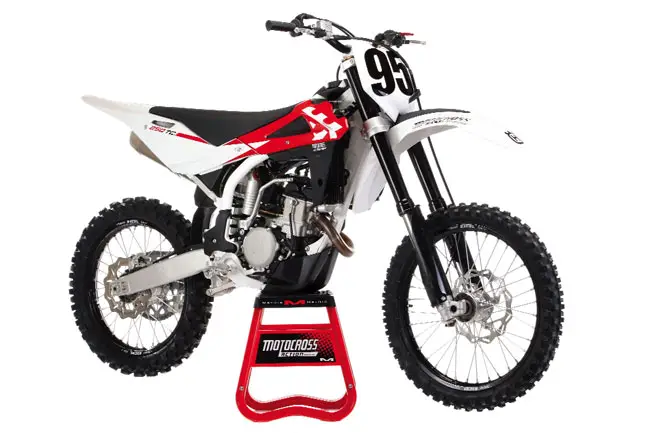
2011 Husqvarna TC250: The Italians are making a serious push at competing on the world circuit with their fuel-injected, lightweight, nimble-handling 250 four-stroke.
Q: FIRST AND FOREMOST, IS THE 2011 TC250 BETTER THAN THE 2010 TC250?
A: Before answering the question, we feel compelled to refresh your memory of the 2010 Husqvarna TC250. The Italian-built bike was praised for its suspension, handling, brakes and tires, but suffered from a weak powerband and suspect starting ability. The 2010 TC250 was, for all intents and purposes, the first step in something that could be excellent?if only several key improvements were made.
For 2011, Husqvarna kept the same basic package as last year’s model, but they made a few refinements… errr, changes. The biggest change came with a Mikuni 45mm EFI throttle body. The Italians were confident that using electronic fuel injection would improve engine performance and ease starting ability?effectively killing two birds with one stone. They succeeded in one area?starting?but failed in another?powerband. The 2011 TC250 trades horsepower for easier starting. What’s better? The ability to start a bike or a more powerful engine (if only the bike could be started)?
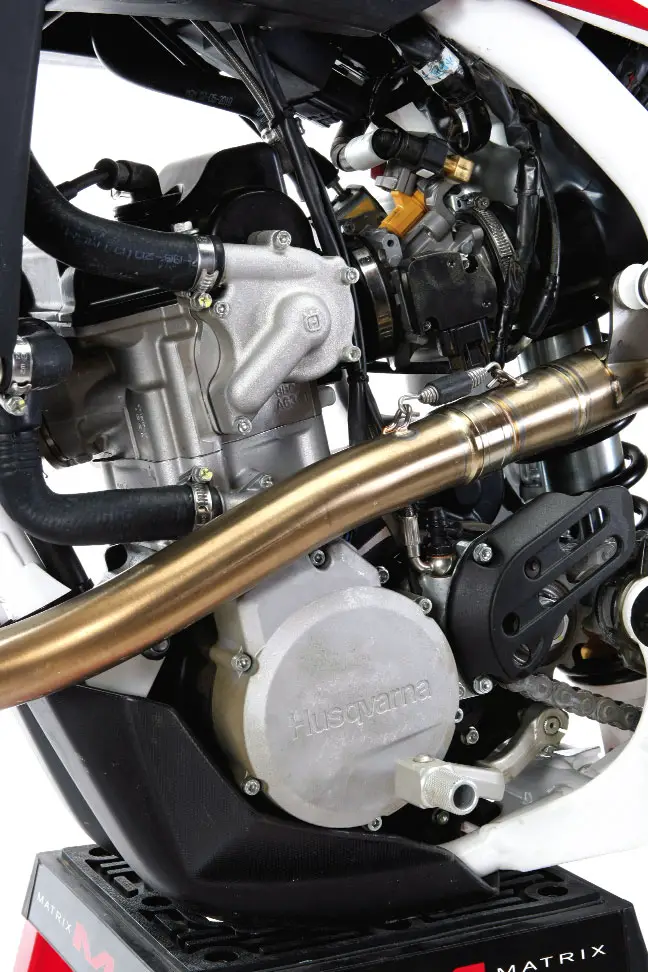
Featherweight: The 48-pound engine is the lightest in the class. Now Husqvarna needs to make it faster.
Q: WHAT ARE THE MOST UNIQUE FEATURES OF THE 2011 HUSQVARNA TC250?
A: Here’s the list:
(1) Engine. Two years ago, Husqvarna designed the smallest and lightest 250 four-stroke motocross engine on the planet. Called the “X Lite,” the 48-pound powerplant is miniscule in size and weight. We’re perplexed as to how Husky packs the valves, cams, piston and rod inside the Vern Troyer-sized engine.
For 2011, Husqvarna revised the cylinder head and used a new cam profile to attempt to improve overall power. The center cases have been reinforced with steel connections where they mount to the frame.
(2) Chassis. Husqvarna isn’t the only manufacturer to rely on a steel chassis (KTM has long used steel for their frames), but Husky’s chromoly, single-tube frame harks back to the days before aluminum frames became commonplace. The MXA wrecking crew appreciates steel frames. Why? Let us count the ways.
Good old steel: When designed properly, a steel frame is lighter than aluminum, more resilient and easier to work on.
Workability: Steel frames can easily be strengthened, gusseted or repaired by a welder. The same cannot be said for an aluminum frame.
Rigidity: Chassis engineers walk a fine line between flex and rigidity in their designs. With steel, that line is widened significantly.
Space savings: The chromoly steel chassis makes it a breeze to get to the preload ring and other areas on the bike that would require a double-jointed person to get to on an aluminum Delta-Box frame. For 2011, Husky focused on the footpeg area of the chassis. Their goal was to create a lighter, slimmer and stronger frame around the footpegs.
(3) Shock. The Husqvarna TC250 has become synonymous with Sachs. While the TC449 uses a Kayaba shock, the TC250 is once again equipped with a German-built Sachs. The MXA wrecking crew had no choice but to live with the Sachs shock, because suspension gurus with Sachs experience are few and far between in the USA.
(4) Styling. The minimalist plastic side panels, jutting lower radiator shroud and upward-facing rear fender are features that are unique to the Husqvarna TC250. The bike looks unlike anything else on the track. And while the side panels don’t favor numbers larger than 6 inches, we have to admit that Husky’s style ventures have had an effect on the style of almost every bike made in the last few years.

Path less traveled: The TC250 comes equipped with Mikuni EFI.
Q: IS THE 2011 HUSQVARNA TC250 FUEL INJECTED?
A: Yes. Husqvarna is the latest manufacturer to join the electronic fuel-injection fray. Husqvarna’s switch to EFI is interesting for two reasons: First, the popular choice when switching to EFI is to use the ubiquitous Keihin system. This tried-and-true fuel-delivery system has become the gold standard in motocross technology, and Husky uses it on the TC449. On the TC250, however, Husqvarna bucked the trend by opting for a battery-less Mikuni 45mm system. Mikuni isn’t new to the throttle-body design (for years the Japanese company has been making throttle bodies for various vehicles), but they are new to the motocross market. Second, of all the major players in the 250 four-stroke market, Yamaha is the only brand to stand pat with a Keihin FCR carburetor in 2011. That’s not to say that Yamaha won’t jump ship and enter the EFI world for 2012?which is really only a few months away. However, for the 2011 model year, the YZ250F is keeping carburetors on the map.

Q: DID ELECTRONIC FUEL INJECTION FIX THE TC250’S STARTING WOES?
A: In a word, yes. Last year (2010), the MXA wrecking crew struggled to start the TC250, especially once the engine warmed up. We declared it to be the most temperamental bike that we had encountered in a decade. Through trial and error, we learned that the easiest way to start the 2010 TC250 was by bump-starting it. That’s not a positive trait.
No more! Although the 2011 TC250 isn’t as easy to start as many other bikes, it’s significantly improved over last year. We attribute that to EFI. On average, the TC250 started once every eight kicks when cold, and once every four tries when the engine was warm. Although the percentages aren’t great, we’ll happily take those odds over last year’s model. It should be mentioned that Husqvarna solved the riddle of their kickstarter getting jammed into the footpeg. We didn’t encounter any of those issues on the 2011 model.
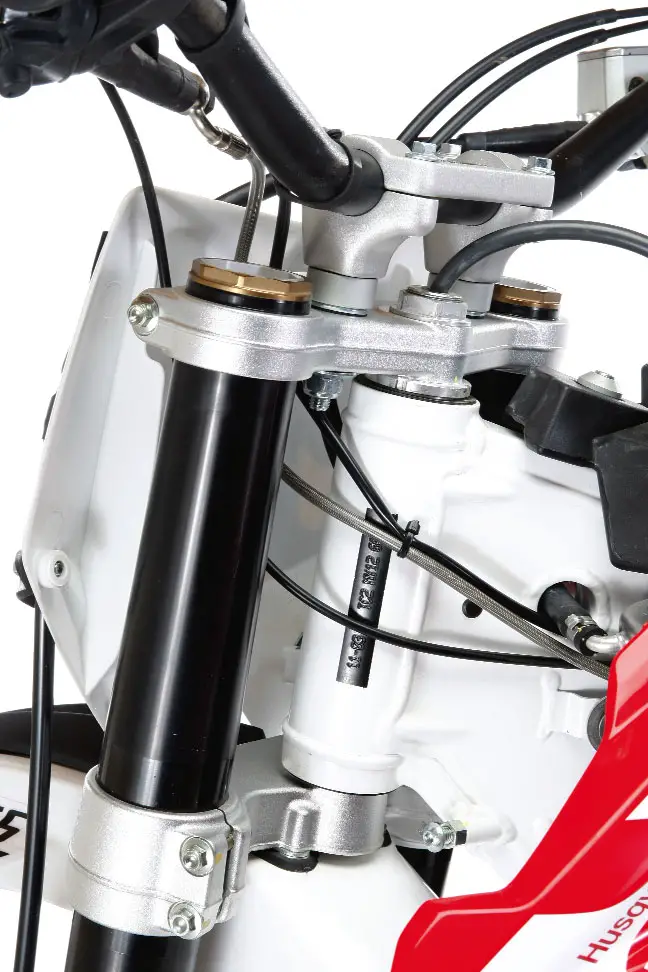
Triple trees: The triple clamps were small in size and the head angle was desirable for every test rider. Good stuff.
Q: HOW MUCH DOES THE 2011 HUSQVARNA TC250 RETAIL FOR?
A: Retail price of the 2011 TC250 is $6999. It is the least expensive 250 four-stroke on the market. To compare, the TC250 edges out the Yamaha YZ250F ($7150), Honda CRF250 ($7199), Kawasaki KX250F ($7299), Suzuki RM-Z250 ($7299), and KTM 250SXF ($7699) on the showroom floor.
Q: HOW WOULD WE DESCRIBE THE 2011 TC250’S POWER?
A: The MXA wrecking crew would be telling tales out of school if we said that the 2011 TC250 was fast. In fact, the engine can’t even be considered moderately fast. Compared to the big-five 250 four-strokes, the Husqvarna TC250 ranks in the cellar. Having said that, the TC250 powerplant has promise. In the right hands, the bike can be competitive; but, in the right hands, any bike can be competitive.
To ride the TC250 effectively requires fearlessness and excellent cornering skills. Just like a locomotive, a Husky TC250 must keep its momentum moving forward. On smooth tracks with loam, the TC250 shines. It is, dare we say, the most fun 250F in the class when conditions are optimal. Wringing out the bike and slicing through corners at a fevered pitch is exhilarating. The TC250 can provide the sensation that no one?not even Ryan Villopoto?can go through corners faster than you. That’s making a statement!
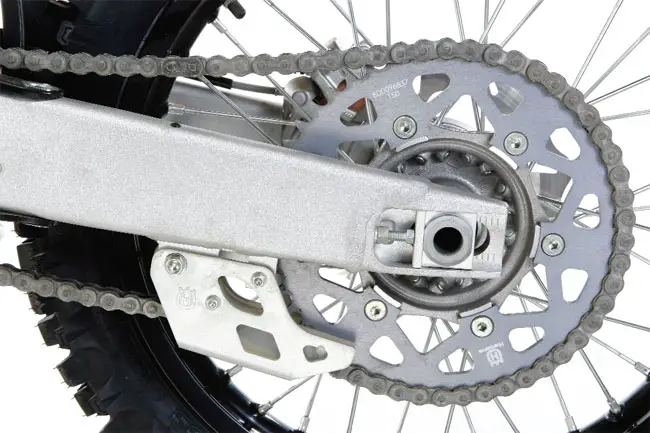
Must-do: It’s imperative to gear the TC250 down for more drive.
Q: HOW DID WE IMPROVE ENGINE PERFORMANCE?
A: Not surprisingly, the MXA wrecking crew yearned for more hit and power. We took a two-pronged approach to improving engine performance.
(1) Gearing. In stock trim, the Husky TC250 comes with a 13/50 gearing combination. On high-speed European circuits, this gearing might be sufficient, but that’s not the case on tight, loamy or sandy tracks. We added a tooth to the rear sprocket in an effort to punch up the low-to-mid powerband. It helped immensely, but we still wanted more hit. Gearing the bike down one more tooth (13/52) yielded a much more racer-friendly powerband. By no means, though, did the 52-tooth rear sprocket solve the riddle that is the TC250 engine, but it did beef up the powerband.
(2) Exhaust. The TC250 comes stock with a high-tech Akrapovic exhaust system, complete with a titanium muffler. It’s a beautiful piece of machinery, but it’s not the best exhaust system for the Husky. Why? For starters, it has a built-in spark arrestor. Several MXA test riders tried in desperation to remove the metal screen, but all attempts failed. Instead, we switched to a Leo Vince exhaust and were rewarded with an immediate boost in performance. The Leo Vince system opened up the engine and gave the TC250 personality.
Q: WHAT DO WE THINK ABOUT THE HUSQVARNA TC250 SUSPENSION?
A: Last year, Husqvarna switched to Kayaba forks after using Marzocchi units for years. If we thought that the Kayaba forks looked familiar, that’s because they were 2007 Yamaha YZ250F units. For 2011, Husqvarna continued their relationship with Kayaba and equipped the TC250 with newer closed-cartridge forks. We were happy to learn of this pairing and hoped that Husky used stiffer fork springs this year. Sadly, they didn’t cure the maladies of the otherwise decent forks by going to 0.45 kg/mm springs. Once we installed stiffer springs, the fork action improved considerably and balanced out the suspension. From there, we used the compression and rebound clickers to find adequate settings for most skill levels.
As for the Sachs shock, we had no choice but to tinker with it. The Sachs shock has a unique feel compared to Kayaba, Showa and WP shocks. The shock feels very springy and is at its best in small chop. We didn’t hate the Sachs shock, and once we stiffened up the front forks, the shock began to feel better.
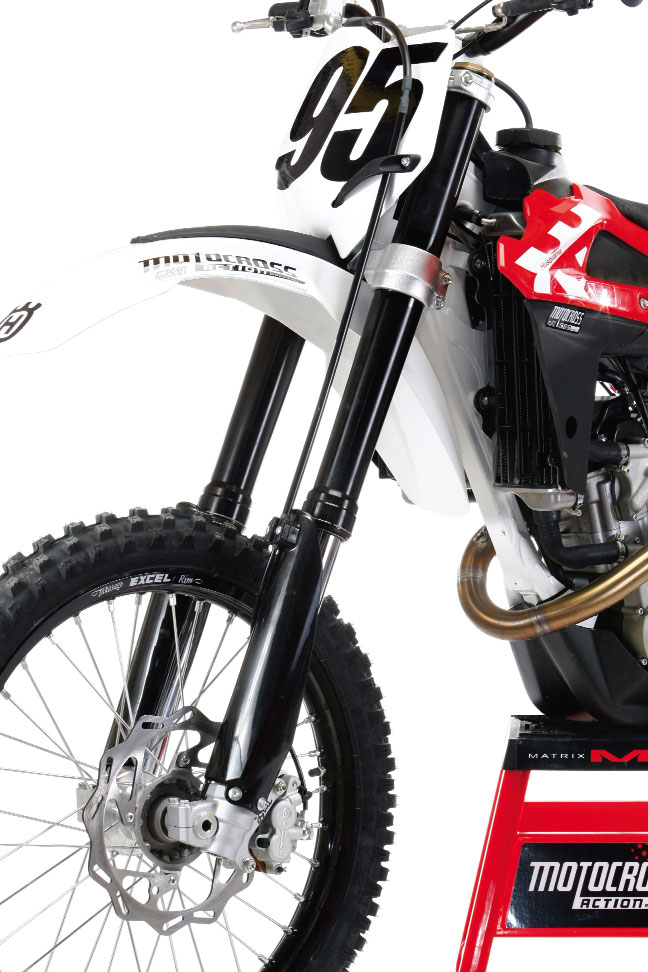
Familiar territory: We found comfort with the Kayaba units once we jumped up a spring rate. Kayaba advice is readily available.
Q: WHAT ARE MXA’S RECOMMENDED HUSQVARNA TC250 FORK SETTINGS?
A: Here is what the MXA wrecking crew ran in its 2011 Husqvarna TC250. Stock settings are in parentheses:
Spring rate: 0.45 kg/mm (0.43 kg/mm)
Oil height: 290cc
Compression: 14 clicks out (9 clicks out)
Rebound: 16 clicks out (13 clicks out)
Fork leg height: 5mm up
Q: WHAT ARE MXA’S RECOMMENDED HUSQVARNA TC250 SHOCK SETTINGS?
A: Here is what the MXA wrecking crew ran in its 2011 Husqvarna TC250. Stock settings are in parentheses:
Spring rate: 5.4 kg/mm
Race sag: 100mm
Hi-compression: 11 clicks out (10 clicks out)
Lo-compression: 16 clicks out (15 clicks out)
Rebound: 16 clicks out (18 clicks out)
Notes: We recommend running between 100mm and 105mm of sag to maximize the shock’s potential.

Q: WHAT DID WE HATE?
A: The hate list:
(1) Engine. This is the slowest engine in the class. It can be improved with different gearing and an exhaust system, but the Husky engine is still down on power.
(2) Fuel injection. We developed a love/hate relationship with the Mikuni EFI system. We loved that it allowed us to start the 2011 TC250 easily, but hated that it mellowed out an already soft powerband.
(3) Forks. The Kayaba units could be excellent if stiffer springs were installed. As it sits, the TC250 is unbalanced and can’t handle rough sections without spiking through the entire stroke.
(4) Gearing. The Husky TC250 has Bonneville gearing. The engine began to pack a punch once we added two teeth to the rear sprocket.

Contortionist: MXA testers loved the feel of the TC250 in the air, but not everyone was happy. Several riders griped about the lack of horsepower needed to get over bigger jumps after exiting corners. They contorted their bodies to help clear jumps.
Q: WHAT DID WE LIKE?
A: The like list:
(1) Handling. The TC250 has a pleasant handling chassis that doesn’t do anything offensive. We can’t say the same thing for many other bikes on the market.
(2) Uniqueness. Owning a Husqvarna means that you’re probably the first person at your local riding area to throw a leg over this unique piece of machinery. The TC250 isn’t for riders who want to conform to the status quo. MXA test riders who had good results in their motos noted that people paid more attention because of the oddity of seeing a Husky TC250 up front. It’s an attention grabber.
(3) Brakes. The Brembo 260mm cauliflower-shaped front brake shares the top step of the braking podium with the brake on the KTM 250SXF. Guess what? Both bikes have Brembo units. This brake has an impressive feel and stopping power.
(4) Styling. It’s different, eye-catching and artistic. The MXA wrecking crew has mixed feelings about the Husqvarna TC250’s body styling. All agree that the minimalistic use of plastic draws the focus to the most interesting aspect of the bike?the miniscule engine. We only wish that we could put numbers on the sides.
(5) Hubs. The new Grimeca aluminum hubs resemble works components. These beefy hubs have a mirror-like finish and seem very strong.
Q: WHAT DO WE REALLY THINK?
A: Husqvarna is inching their way up the ladder with the TC250. The Italians have a competent machine that is well suspended, corners like a hummingbird, brakes on a dime and, best of all, starts easier. However, Husky needs to pump up the volume on the TC250 powerband. There is no honor for an engine designer in building the slowest engine in the class. Husqvarna’s engineers need to look to another Italian company for inspiration?Ferrari.





Comments are closed.